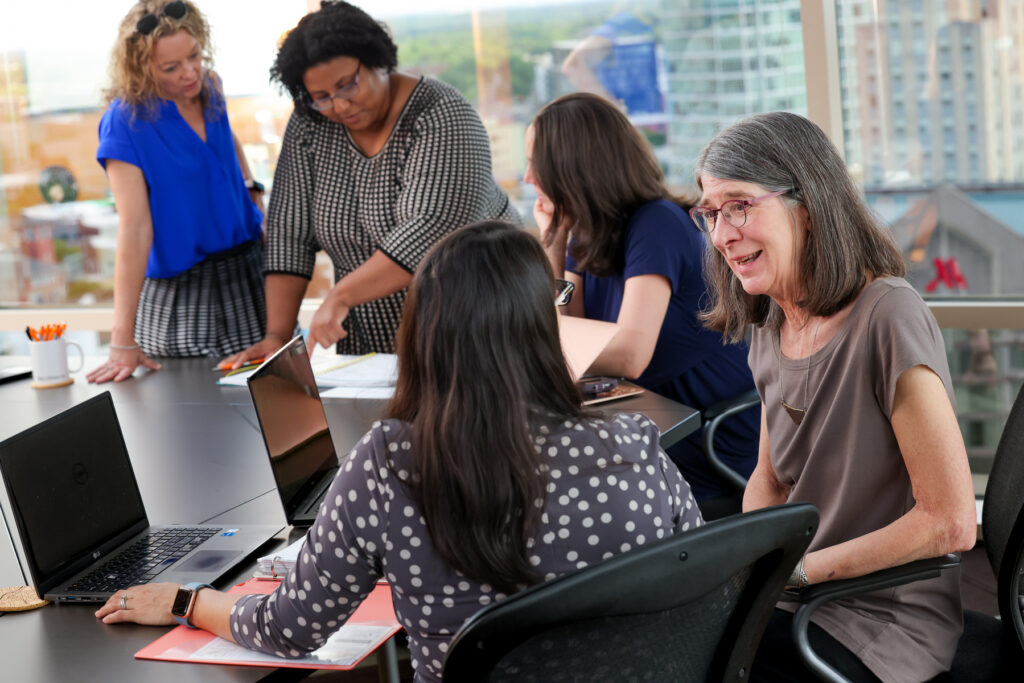Do great minds think alike? Sometimes, yes. But a lot of the time, they don’t. That’s not necessarily a bad thing. In fact, it can be a great thing. Bringing people together who have different ideas, backgrounds and opinions can produce deeper levels of understanding and push each individual’s thinking, while also pushing the work in new directions.
During the 2021-2022 school year, Catalyst evaluators worked with many great minds from a client team and their Teacher Advisory Group (TAG) to write a paper together. In leading this effort, I experienced the associated benefits of group-think as we wrapped up a multi-year project with the Maine Math and Science Alliance (MMSA.) MMSA had been supporting teachers with the use of WeatherBlur, their web-based citizen science program, and Catalyst evaluated the ways in which the TAG informed the ongoing development of the program. As we engaged with the TAG and MMSA staff, observed their interactions, and interviewed them about their process, we learned a lot about how to effectively construct and execute a co-design process between researchers and practitioners. (Stay tuned for more about that in the future, as we have submitted those findings for publication.)
Upon completion of the manuscript, we reflected on our role in the project and realized that, although their co-design process was the focus of our analysis, it wasn’t the only thing that taught us something. By working so closely with MMSA staff and the TAG to help them articulate their co-design methods, we also developed a process for how to integrate research and practitioner voices in the writing process.
Corralling so many people with diverse schedules, perspectives, and WeatherBlur experiences in an effort to create one cohesive written summary was, at first, daunting. But, in the end, it was a valuable learning experience, and one we think we (and others) can replicate with other writing groups. Here are some of the key things we learned about how to make this type of collaborative writing process effective. (Stay tuned for more on this too. We’re hoping to provide more articulated guidance in the future.)
Strategies for a successful writing collaboration:
-
- Timelines. As the lead writers, we drew upon our experience with academic writing and journal submission. Catalyst staff knew the end point, and we knew the milestones along the way that we needed to hit in order to meet our deadline. From the first writing group meeting, we laid out the schedule for all the writing tasks from brainstorming, to drafts, to editing and final submission. We adjusted our timeline around our collaborators’ availability. For example, teachers had more free time to write in the summer, so we delegated their writing time in June-August. The MMSA staff contributed their content in May-June, and served in an editing capacity in August-October once the teachers’ sections were complete.
- Checking in. Although we spent a lot of time talking up-front about the vision for the paper, it understandably evolved through the writing process, and we all had questions. So, we made a point of scheduling monthly meetings where we could talk through the challenges and brainstorm solutions together. Sometimes these sessions were conceptual discussions. Other times they were editing sessions, with the paper in front of us. We left the structure open so that meetings could serve whatever purpose was needed at the time.
- Schedules. We committed to a meeting time that worked for everyone, and we stuck to the same day and time for every meeting. We sent reminders, with specific tasks for everyone to complete in preparation for each session. When we honored everyone’s commitment, participation levels were high.
- Respect. Once the writing was finished, Catalyst evaluators took on the task of merging all the sections together to make the paper cohesive. This involved a good deal of massaging and editing so that the voice, tone, and style were consistent, despite having been written by many people. Here we had to make sure not to lose the perspective of each individual author. While admittedly challenging, this aspect may have been the most important, and most deliberate, secret to our success. Our thesis was clear, and we wrote the abstract early in the writing process. We referenced these statements constantly throughout the writing and editing process. They served as guideposts for all writers to ensure that their content referred back to our mutual intentions. So, although each writer may have used their own tone, they all focused on the same message. We revisited our talking points during each check-in meeting. We referred to them in our emails and in comments to each other within the document. By reminding each other, and ourselves, of the collaborative decisions we had made along the way, we honored our commitment to create a paper that included the collective perspectives of all writers.
- Agreement. Finishing a journal article is like a giant exhale. But we couldn’t fully breathe until we knew that ALL the authors agreed to the final product and so we sent the edited version back out to everyone for a final review. Thankfully we received minimal corrections, and everyone agreed it was ready to go.
Now our paper is out for review and we’re crossing our fingers that the world wants to hear the story we told. Regardless of that outcome, we’re happy to also tell the story of how that manuscript came to be, and how much we learned in the process. Many thanks to the “great minds,” who we worked with at MMSA and the TAG for the opportunity to share in such a collaborative project.
Get in touch!
Want to co-create with us or work with us to lead a co-created writing project with a community of interest? Click here to share your idea, and let’s have a chat!




